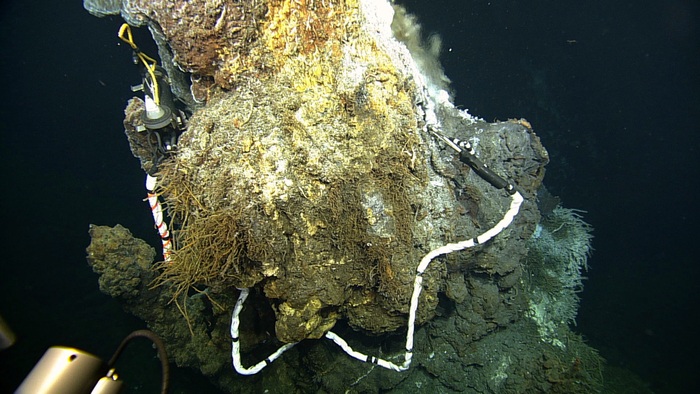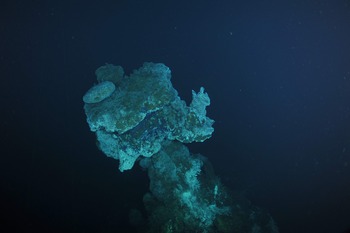We’ve been treated to some amazing seafloor scenery over the past day and night as ROPOS has surveyed sites and then deployed instruments in the International District hydrothermal vent fields associated with Axial Seamount. Sulfide structures encrusted with life forms, such as tubeworms with blood-red plumes and clusters of purple protists called ciliates, kept many of us on the ship riveted to the monitors showing the live video feed, the same stunning imagery that viewers on shore were seeing at nearly the same time. Knowing that these life forms that live without sunlight, nourished by the heat and minerals pouring out of the seafloor, were just one mile below our feet here on the ship, added an extra frisson of excitement.
The purpose of the first ROPOS dive to International District yesterday was to seek out and survey good locations for deployments of a gas-sampling instrument and a temperature-resistivity probe. In addition, a sample of sulfide rock was taken from the El Guapo structure and carried back up to the ship where perhaps the most excited person onboard was College of Charleston student Montgomery Taylor whose project for this cruise is on hydrothermal vents. A crowd quickly gathered around the lab bench where the rock was set to rest. It had a velvety surface of oxide red and gave off the faint smell of sulfur. Less than two hours before, this chunk of rock had existed in the rarely seen environment of a deep-sea underwater volcano. Now, here it was before us.
ROPOS was sent down again for dive #1618, carrying the instruments to be deployed and returning to the structure selected during the survey dive, a structure known as Escargot for the eponymous snail-like formation at the top. Carefully maneuvering in close, the ROV held the gas sampling instrument in shimmering hot fluids of some 270°C (~500°F) to capture the dissolved gases and keep them under deep-sea pressure during the return to the surface and until they could be analyzed.
Next up was a trial deployment of the battery-powered temperature-resistivity probe designed by Marv Lilley at the University of Washington. For this operation, the amazing dexterity of the ROPOS manipulator arms was put to good use. After enlarging one of the holes where Escargot was venting fluids, the probe—a long tube made of titanium—was inserted. The data collection part of the instrument, known as the “pig,” was settled securely on a flat spot found on the other side of the structure. A cable joined the two components. This instrument will be recovered during the next leg of VISIONS ’13. By summer 2014, the probe will have been adapted and deployed to be plugged in the cable, no longer dependent on the short-term solution of using batteries for power.
Contributed by Nancy Penrose, RSN Communications Coordinator




